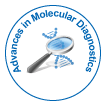Research Article
Evaluation of Four Loop-Mediated Isothermal Amplification (LAMP) Assays for Identification of Shiga Toxin Producing E.Coli O157 (STEC) and Non-O157 Strains
James Mahony1,2*, Sylvia Chong2, Chris Stone2 and Linda Chui31Department of Pathology and Molecular Medicine, McMaster University, Canada
2Regional Virology Laboratory, St. Joseph’s Healthcare Hamilton, Hamilton, Canada
3Provincial Laboratory for Public Health, Walter Mackenzie Health Sciences Centre, University of Alberta Hospital, Edmonton, Alberta, Canada
- *Corresponding Author:
-
Mahony JB, Professor
Regional Virology Laboratory
St. Joseph’s Healthcare Hamilton
50 Charlton Ave. E, Hamilton
Ontario L8N 4A6,Canada
Tel: 905522-1155
Fax: 905521-6083
E-mail: mahonyj@mcmaster.ca
Received: March 01, 2016; Accepted: March 15, 2016; Published: March 21, 2016
Citation: Mahony J, Chong S, Stone C, Chui L (2016) Evaluation of Four Loop-Mediated Isothermal Amplification (LAMP) Assays for Identification of Shiga Toxin Producing E.Coli O157 (STEC) and Non-O157 Strains. Adv Mol Diag 1:104.doi:10.4172/amd.1000104
Copyright: © 2016 Mahony J, et al. This is an open-access article distributed under the terms of the Creative Commons Attribution License, which permits unrestricted use, distribution, and reproduction in any medium, provided the original author and source are credited.
Abstract
Shiga toxin-producing strains of E. coli are a significant cause of food-borne outbreaks of gastroenteric disease. The objective of this study was to evaluate loop-mediated isothermal amplification (LAMP) assays for the identification of Shiga toxin producing E. coli O157 (STEC) and non-O157 strains. Four LAMP assays were developed for the detection of the rfbE gene of E. coli O157, the Shiga toxin genes stx1/stx2 and eae intimin gene. The assays were run on a real time fluorometer (Genie II, Optigene, Horsham, UK) that displays real time amplification, the time to positivity and amplicon annealing temperature (Tm). The specificity of the LAMP assays was confirmed by testing a panel of 35 enteric bacteria, viruses and parasites, all of which tested negative in all four assays. The lower limit of detection for each of the gene targets was 10-100 genome equivalents and 1 cfu of E. coli O157. The LAMP assays were evaluated by testing a total of 135 stool specimens by LAMP, PCR or the xTAG® Gastrointestinal Pathogen Panel (GPP) assay (Luminex Molecular Diagnostics, Toronto, ON, Canada). Following resolution of the discordants and using positivity in two or more assays as the reference standard, the sensitivity of the LAMP assays was 100% (27/27), 98.4% (63/64) and 98.0% (47/48) for rfbE, stx1/stx2 and eae genes respectively, while the specificity for the assays was 100% (107/107), 100% (71/71) and 98.5% (66/67), respectively. The LAMP assays had excellent sensitivity and specificity for detecting Shiga toxin-producing E. coli O157 (STEC) and non-O157 in stool specimens and they were faster and more accurate than PCR. We suggest that these assays could be incorporated into E. coli O157 (STEC) testing algorithms.

 Spanish
Spanish  Chinese
Chinese  Russian
Russian  German
German  French
French  Japanese
Japanese  Portuguese
Portuguese  Hindi
Hindi